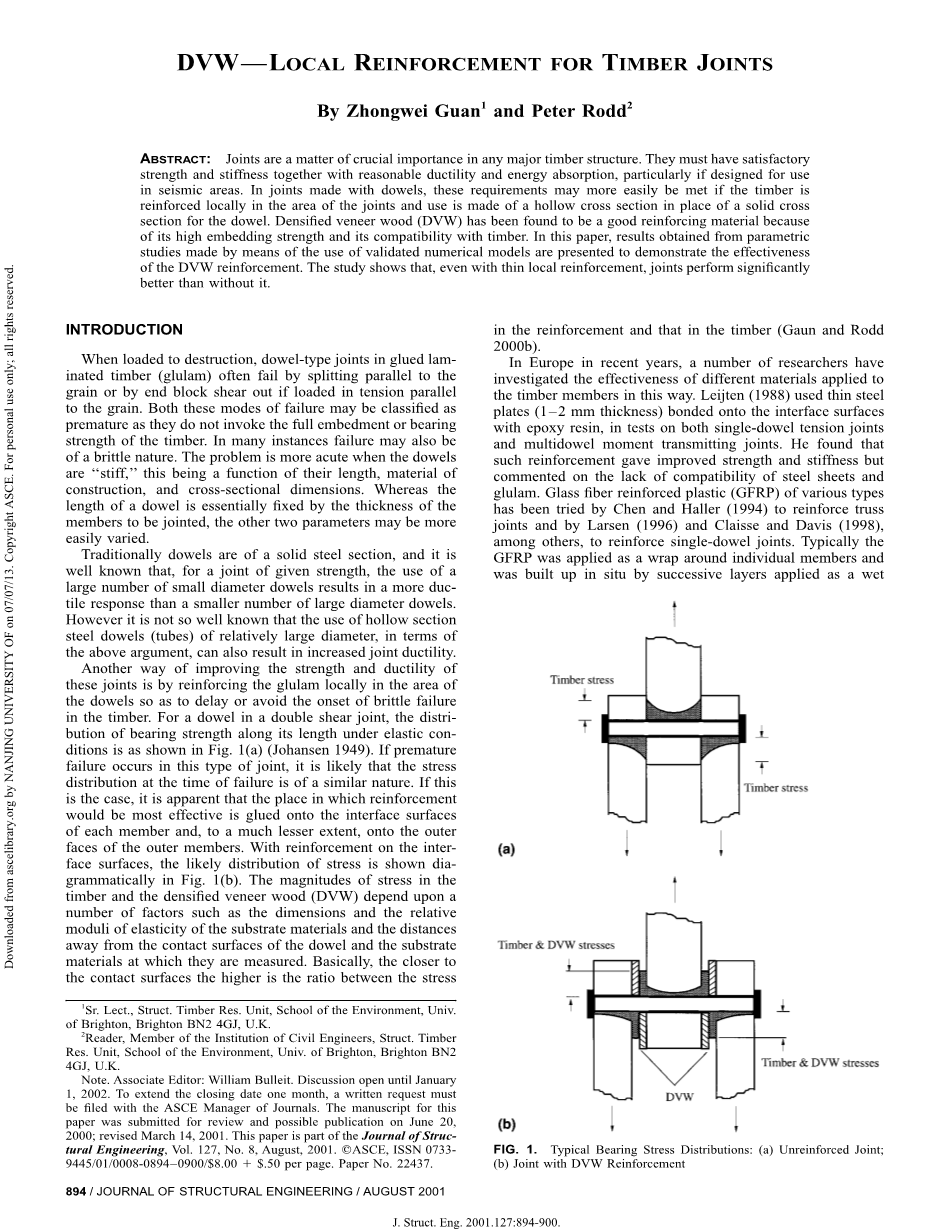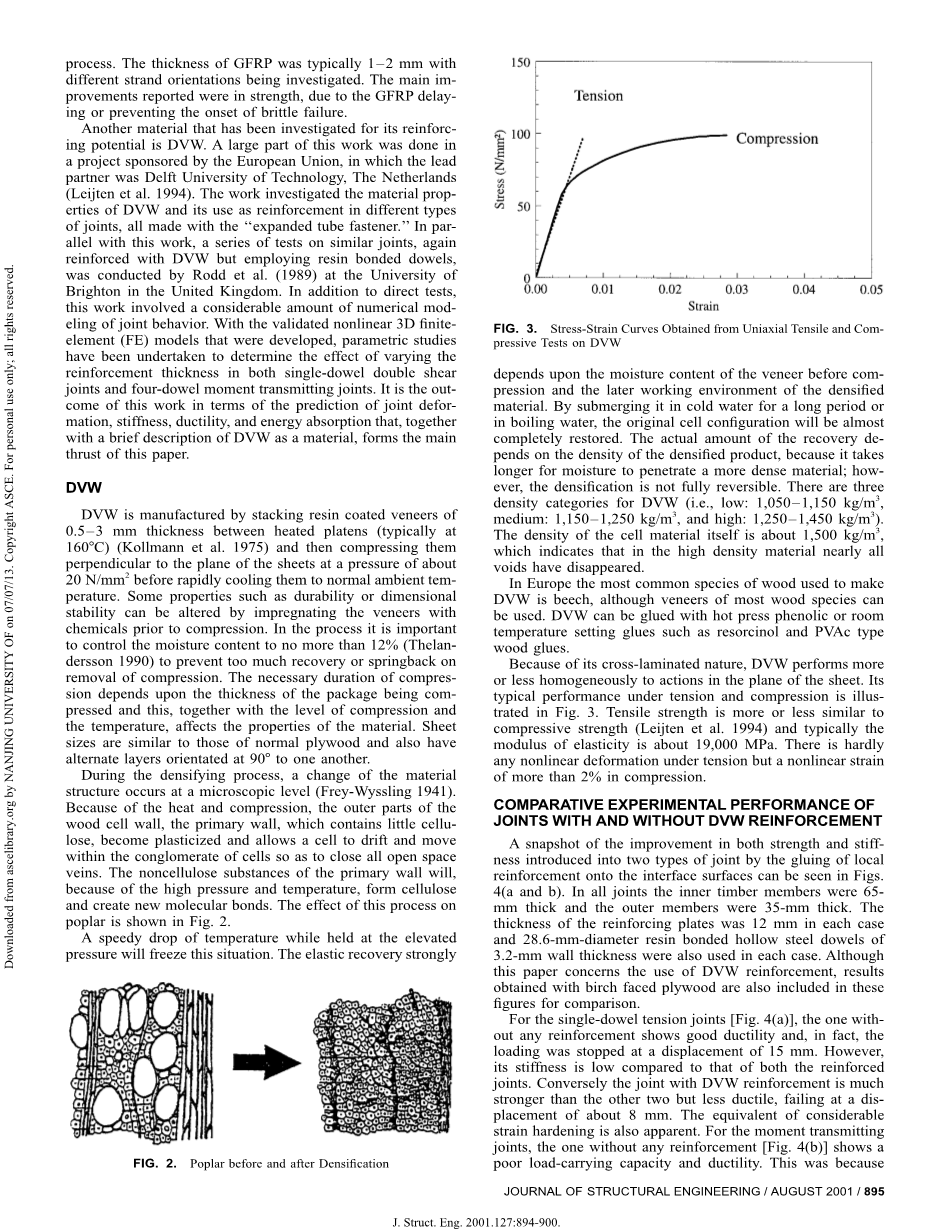英语原文共 7 页,剩余内容已隐藏,支付完成后下载完整资料
Journal of Constructional Steel Research 126 (2016) 201–213
Contents lists available at ScienceDirect
Journal of Constructional Steel Research
Seismic performance of hybrid self-centring steel-timber rocking core walls with slip friction connections
Ashkan Hashemi , Reza Masoudnia, Pierre Quenneville
Department of Civil and Environmental Engineering, Faculty of Engineering, The University of Auckland, Private bag 92019, Auckland 1142, New Zealand
a r t i c l e i n f o
Article history:
Received 14 April 2016
Received in revised form 12 July 2016 Accepted 13 July 2016
Available online 22 July 2016
Keywords:
Rocking core walls
Cross Laminated Timber
Slip friction
Low damage
Energy dissipation
Self-centring
Steel strands
a b s t r a c t
While structures with conventional lateral force resisting systems are designed to meet the life safety criteria for the residents during and after a seismic event, they are allowed to tolerate the expected structural damage. This damage might be because of the residual displacements after the earthquake or the lack of ductility in the system. Despite the fact that the allowable damages are intended to be repairable, however, in most cases the repairs are highly uneconomical. A self-centring hybrid steel-timber rocking core wall system (SC-RW) is developed to pro-vide sufficient ductility in addition to a significant amount of energy dissipation while it limits the residual drift and the associated damage. This system is comprised of one or more rocking cross laminated timber (CLT) walls with slip friction connections as the main lateral resisting system and steel beams and columns to resist against gravity loads. Horizontally oriented post-tensioned strands through the beams provide additional moment resis-tance at the beam-column interface to re-centre the structure after the earthquake. The efficiency of the proposed system is investigated under cyclic and seismic loading regimes. Furthermore, a preliminary displacement based design approach for a SC-RW system is introduced. Dynamic time-history simulations confirm an excellent be-haviour in terms of drift capacity, residual displacement and peak roof accelerations.
copy; 2016 Elsevier Ltd. All rights reserved.
1. Introduction
Structural walls provide excellent seismic resistance and are com-monly used as the main lateral resisting system in buildings. During the past seismic events, these walls were found to represent superior seismic performance compared to other alternative structural members [1–3]. Those walls constructed with prefabricated components have ad-ditional advantages including offsite fabrication, improved quality and speed of construction. During the 1994 Northridge earthquake, several commercial precast parking structures experienced significant damage [2], however, this damage was mainly because of incompatibilities be-tween the lateral and gravity resisting systems and no considerable damage was observed in the walls themselves. Furthermore, during the 1995 Kobe earthquake, precast concrete buildings with structural wall systems performed well with negligible post-earthquake damages.
Recently, there has been an extensive interest towards the design and construction of multi-story timber structures with engineered wood products such as Cross Laminated Timber (CLT) and Laminated Veneer Lumber (LVL) panels. However, the application of these prod-ucts in seismic regions as the primary lateral resisting system was lim-ited firstly due to the lack of information about their seismic behaviour, secondly the subsequent restrictions imposed by the design codes and thirdly because of their non-ductile behaviour which leads to
Corresponding author.
E-mail address: ahas439@aucklanduni.ac.nz (A. Hashemi).
http://dx.doi.org/10.1016/j.jcsr.2016.07.022 0143-974X/copy; 2016 Elsevier Ltd. All rights reserved.
relatively high response accelerations. During the large-scale experi-mental investigation of a seven story building made of CLT panels with-in the SOFIE project, accelerations as high as 3.8 g were recorded [4]. Despite the fact that these accelerations may be acceptable for human health, they are uncomfortable and unpleasant for the habitants. As an important outcome of the SOFIE project, other research studies were commenced in order to mitigate the earthquake damage by developing new solutions to absorb the seismic energy and decrease the ensuing re-sponse accelerations.
This study seeks to develop an innovative steel-timber rocking core as the main lateral force resisting system to efficiently lessen the post-earthquake damage. This system includes supplementary slip friction dampers to dissipate the seismic energy along with high strength post-tensioned steel strands through the beams to self-centre the struc-ture after the earthquake. The efficiency of this system is inspected through displacement control quasi-static analyses. Furthermore, a dis-placement based design approach is introduced to design the system in accordance with the induced seismic loads. Finally, the designed system is subjected to dynamic time-history simulations to investigate its seis-mic performance in terms of provided ductility, self-centring capacity and the peak roof accelerations.
2. Research background
Rocking mechanism for earthquake protection dates back to the Greek era, where segmental construction of columns led to gap opening
202 A. Hashemi et al. / Journal of Constructional Steel Research 126 (2
剩余内容已隐藏,支付完成后下载完整资料
资料编号:[613094],资料为PDF文档或Word文档,PDF文档可免费转换为Word
课题毕业论文、外文翻译、任务书、文献综述、开题报告、程序设计、图纸设计等资料可联系客服协助查找。




